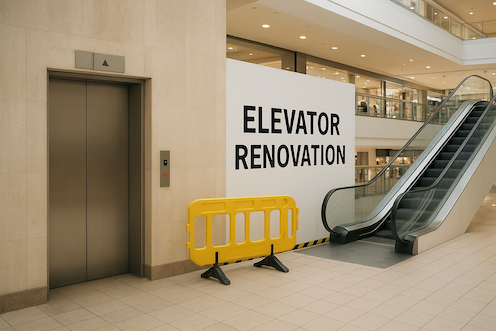In the core business district of a certain second-tier city in the south, a department store that has been operating for 20 years is currently facing a transformation crisis. With the rise of new commercial complexes in the surrounding area, this once highly popular store has gradually become less busy. The management decided to invest in renovations, upgrading the traditional department store into an experiential shopping center that combines dining, entertainment, and retail. However, when the construction team arrived on site, an apparently ordinary elevator renovation project unexpectedly revealed the deep contradictions between the old building and modern commercial demands.

The shopping mall originally had 4 passenger elevators with a capacity of 1000 kilograms each. Due to their service life exceeding 15 years, they frequently broke down, causing passengers to be trapped between floors. The renovation plan proposed by the management team was to upgrade two of these elevators into sightseeing elevators to enhance the overall style of the mall. However, when the construction team removed the elevator shaft walls, they discovered a fatal problem: the original elevators used a hydraulic drive system, and a 1.5-meter-deep oil pit needed to be reserved at the bottom of the shaft. But the second basement floor of the mall was already planned as a parking lot, and the presence of the oil pit would directly reduce the number of parking spaces.
The more troublesome issue is that the control system of the old elevator still uses relay logic from the 1990s, which is completely incompatible with the modern intelligent dispatching system. To implement functions such as multi-level parking and passenger flow statistics, new lines need to be laid. However, the pre-installed pipelines in the concrete structure of the shopping mall have already aged and corroded, and digging the walls might cause structural safety problems.
According to statistics from the China Special Equipment Safety and Energy Conservation Promotion Association, over 15-year-old elevators account for 12% of the total in China. Among them, 60% are located in commercial buildings. The maintenance costs of these elevators are more than three times that of new elevators, and their failure rate is five times higher. A third-party testing agency's follow-up survey of 500 old elevators showed:
76% of the elevators have excessive wear on the brake;
43% of the elevator door lock circuits have contact problems;
28% of the elevators' steel wires have reached the scrapped standard but are still in operation.
In the case of the shopping mall renovation, the original plan was to invest 2 million yuan for elevator upgrades, but the actual cost exceeded expectations:
When dismantling the old elevator, it was discovered that the shaft dimensions did not comply with the new national standards, and an additional 300,000 yuan was needed for structural reinforcement;
To match the intelligent system, all floor buttons and sensors had to be replaced, adding an extra 150,000 yuan;
Due to the construction delay, the shopping mall was closed for 2 months, resulting in a direct loss of over 5 million yuan.
Facing the common challenges in the renovation of old buildings, industry experts point out that the upgrade of elevators should adhere to three major principles:
Compliance priority: The new elevators must comply with the "Special Equipment Safety Law" and local regulations, such as requirements for barrier-free design and emergency rescue passages;
Compatibility consideration: While retaining the original shaft structure, choose elevator products with modular design to reduce on-site construction volume;
Forward-looking planning: Reserve IoT interfaces to create conditions for future integration into smart building management systems.
The technical director of an international elevator brand disclosed: "When we renovated the elevators for a hotel built in the 1980s, we adopted an inorganic room design, moving the control cabinet to the top of the shaft. This not only saved the machine room space but also avoided environmental pollution caused by oil. At the same time, by installing an energy feedback device, the energy consumption of the elevator was reduced by 40%."
The renovation predicament of the old shopping malls reflects the common challenges in China's urbanization process. According to data from the Ministry of Housing and Urban-Rural Development, there are approximately 2 billion square meters of old commercial buildings across the country, and 80% of these elevators have upgrade needs. Industry experts suggest:
Establish a full life cycle management file: Start recording each maintenance and repair data from the installation of the elevator, providing a basis for later renovations;
Introduce a third-party assessment mechanism: Before the renovation, entrust a professional institution to conduct a comprehensive assessment of the building structure and elevator condition to avoid "decisions made on a whim";
Explore diversified financing models: Through government subsidies, equipment leasing, energy management contracts, etc., reduce the one-time investment costs for enterprises.
Now, the renovation of that southern shopping mall is nearly complete. The newly installed glass escalator has not only become the visual highlight of the mall, but also shortened the waiting time for passengers to less than 30 seconds through the intelligent scheduling system. This elevator renovation controversy eventually turned into an opportunity for commercial upgrading, and also provided valuable experience for similar projects - at the intersection of technological iteration and urban renewal, only by treating every detail with reverence can a perfect balance of safety, efficiency and cost be achieved.
